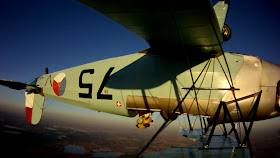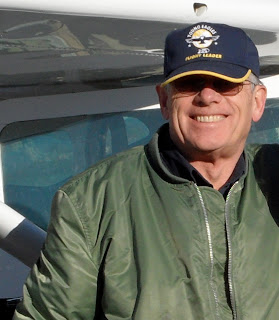Friday's Fabulous Flyer!
Captain Yaw changing lives in Ghana
Where did Captain Yaw come from and what does he do?
Born Jonathan Porter, sometime in the 1960’s to a farming stock mother and a Cockney salesman father, grew up dreaming about working in the developing nations on food security issues. At the age of 11 he was the victim of a brutal case of school bullying, leaving him partially paralyzed on left side and both legs. Determined to overcome--- he left the wheelchair behind and eventually regained full motor control.
Scoring high in academics, he dreamed of becoming an Agricultural Botanist, and was making great strides. Sadly, an accident just before completing his pre-university qualifications left him physically compromised with a broken vertebrae and two ruptured disks. Five surgical interventions later, he was told that he would never work or carry more than a kilo or two. His belief that the mind controls the body more than the body controls the mind, coupled with a strong faith and belief in miracles, this young man, who was obliged to leave school for financial reasons, took a job in engineering.

A natural feel for mechanical things was quickly discovered, and he eventually became CNC robotics trouble-shooter, working on a variety of projects--- Aerospace, motor racing, HVAC and even parts for the production of Rolex watches. Whether it was the computer side, design, machining, or inspection, his insatiable appetite for all that works together drove him onwards.

In 1988, while working in the UK, he took a trial flight at Sywell
Aerodrome, in a Cessna 150, G-AWUN, and it opened a door deep in his
heart. Once swung open, that door refused to close. And Jonathan began
to suffer from ground sickness--- the condition experienced by spending
too long on the ground.
With the economic challenges of
the ICT and related operations at the end of the 1980’s in the UK,
Jonathan and his family moved to France. Not long after settling into
the French Alps area where he worked on small diameter machining
systems, multi-axis flexible manufacturing operation and related
software development, he was involved in motor accident, skidding out on
black ice on the mountains – again leaving him physically compromised
and unable to walk or lift things
French Alps
Furthermore, it was made clear by the medical professionals that he
could not, at that time, retain a French Aviation Medical.
After
long therapy, and more pig-headed stubbornness, he regained working
strength. The doctor treating him being a fan of gliding and the LSA
class of aircraft, encouraged him to consider ‘sub-ICAO aviation’. In
France there are thousands of small birds, flown with a passion, they
are called ULM (Ultra-Léger Motorisé or Ultralight), but that is a very
different classification to FAR Part 103, it is rather much closer to
the LSA rules their friends from over the pond are familiar with.
As
his terrestrial strength grew, the desire to be in the air grew
stronger than ever. Being limited on the ground is easily overcome by
being free in the air! Ever gaining physical strength, and able to fly
the ULM without an aviation medical, he purchased a Weedhopper, landing
in fields and flying around the French Alps, Jonathan gained a lot of
experience in low-inertia flying machines, mountain flying and how to
get out of challenging conditions, not to forget the obligatory engine
completely off landings on a regular basis!

Weedhopper
In 1994 some would refer to it as a ‘calling’, others a ‘yearning’ and
some ‘coincidence’, but for Jonathan, it was destiny. Jonathan took
his family to Ghana in West Africa to work on a contract with USAID
relating to data systems. Of course the household belongings and the
Weedhopper were sent in the same container. As much as flying in 1988
opened the door to Jonathan's yearning to fly--- going to Africa blew
open the side of the building revealing the need and opportunity of
Africa, and it stole what remained of his heart. Thus, flying and
Africa joined hands driving the beat in this man's chest.
DC8
On one particular flight out of Ghana, Jonathan ‘hitched’ a ride in a
cargo DC8 ... Ah, the days before 9/11. He spent enough time in the
cockpit to realize that flying heavy metal could never provide the same
feeling and satisfaction of the lighter aviation scene. As he says ‘why
drive a bus when you can drive a racing car?’.
Named ‘Yaw’
meaning Thursday born in local parlance, by the Paramount Chief of the
Osuduku area in 1994, and the name sticking ever since, the stubborn
pilot insisted on flying more and more, even though he only had a
2-stroke engine up front. 2-strokes consume fuel and are less reliable
than our 4-stroke engines, but when you know you can land on a pocket
handkerchief, and you have not had an incident, you do not always
appreciate that fact.
One day, flying from Accra to
Kumasi, the weather deviations consumed too much fuel – and the thirty
minutes extra soon became ten. So a precautionary landing in a village,
surrounded by tall trees and hostile terrain, not only developed a new
set of skills, but it also created a new train of thought.
Moving back to the UK in 1997, the Weedhopper was left in the hands of a friend, and Jonathan lectured in college and university course subjects, despite never having undertaken a university course. When he applied for a degree, he got asked to teach on it instead! Experience is of far more use than certificates!
During his teaching time he flew both at Shoreham in Sussex in the PA28
and Cessna family, and with the Tiger Club at Headcorn in Kent, enjoying
the Piper Cub, Jodel Mascarat D150, Tiger Moth and other wonderful
aircraft. Although flying, the call of Africa was still pulsating in his
chest.
In 2002 he returned to Ghana, with the determination to
create a flying school and engineering centre of international standards
– to be operated by Ghanaians.
Supported by a group of
international shareholders, WAASPS was born, but not without a few
administrative struggles! Wining friends to a new industry is not
always easy, but it can be done with a large dose of determination. So,
in November 2005, Kpong Airfield opened its doors, with only 300m of
usable runway.

In January 2006, meetings held, discussions ensued, and letters sent to
the missions in Ghana about the opportunities available to use aviation
to reach the hard to get to places in the country--- without success.
They were told that ‘rural aviation is not possible here’.
Then
in March 2006, Matthew, the 21 year old son of Jonathan , a keen
agricultural enthusiast, was returning from taking soil samples to the
city. On the way back, a small bus crossed the white line and hit
Matthew head on. The vehicle was destroyed and the passers by put
Matthew with the other ‘dead’ in the back of a pickup truck to send to
the mortuary.

At the hospital, as they were about to send the broken and bleeding
limp form to be laid out, a nurse heard shallow breathing. About the
same time Jonathan arrived at the hospital. Matthew received massive
injuries, bone was protruding from his leg, feet wrapped around into
balls of flesh and his left fore-arm cleanly broken, creating an
apparent second elbow. The hospital had no splints, was running out of
stitches and other supplies. The doctor looked at Jonathan and asked ‘
What should I do – I have never seen somebody with so many injuries
still alive.’
Calling on the support of an Air Force friend,
they were directed to go to the city, but by road. At the hospital in
Accra, Matthew was stabilised and then flown to the UK where 4 surgeons
worked for over 8 hours to put him back together. His body weak, but
his mind strong-- just like his Dad.
From that hospital bed in
2006, Matthew decided that it was not possible to wait for the Health
Authorities, missions and others to make the first move on Aviation
Medical Solutions, and so he created the charity Medicine on the Move
from a hospital bed in the UK.
Click here for UK News Despite
the setback, and anguish, it was clear that progress had to be made if
Humanitarian Aviation was to succeed, at least from the light aviation,
affordable aviation solutions perspectives.
Matthew spent 6
months in hospital and insisted on returning to Ghana ahead of the
doctor’s advice. His mind set on ‘doing something to change minds and
perspectives’.

They knew that sponsorship of young people has always been the only answer to long term solutions in every industry. Thus potential laden young men were sought out and given opportunities. Sadly, as soon as they gained a little knowledge they would wander off, seek their fortune elsewhere, become frustrated at the length of time it takes to learn aviation or be caught indulging in practices dangerous to aviation.
Employing exclusively young men at the time, it was a surprise when a young lady walked out of the bush in mid-2007, and asked for a job. At that time, we had no work other than clearing bush-land, and in an attempt to put her off the idea, she was given a machete and mattock and told to clear stumps.
Patricia with Emmanual Bedzrah
Patricia took to the task like a beaver, practically chewing the trees
out of the ground. She arrived early to work, walking several miles
from the mud and thatch home, without power and where water was fetched
from a standpipe, stayed late when needed and turned up on days she was
not working to watch the planes. For this young lady the concept of
learning to fly, becoming a pilot and become an engineer was an
impossible, 'unallowable' dream. It was never envisioned that she would
be a long term part of the operations because ‘the focus was on the
wrong set of people’, explains Jonathan.
One day she was
clearing shrub-land around the workshop when the engineering assistant
was caught stealing, and so, as he was sent to the police station,
Patricia was called to hold a wing. She quickly took to the task in
hand, and learned by watching and asking questions. In the next month
she asked more questions than all of the previous staff combined. Thus
she learned, and then on a ferry flight was given control for the first
time. ‘She took to flying like a natural’ and did not look back.
Flying 97 women and Girls 2010
Her efforts and determination changed the face of the whole
operation. Young women were now given opportunities, and they did
better, tried harder and were demonstrably better investments of time,
energy and finances. Even those who did not last the course, still
provided a better return on investment, leaving only to return to school
to further their studies. Thus the focus changed for WAASPS and
Medicine on the Move, the workshop personnel focus shifted for the
better.
Of course, mistakes are part of learning, and so it
was decided early in 2010 to start a small school by the end of 2010,
taking in just four girls per year, training them in aircraft building
and maintenance, flight training, airfield operations, robotics
engineering (for part production), and computers. A big commitment from
a small company, powered by the pounding in the chest created by
aviation and Africa combined – a very powerful force indeed!
Patricia Teaching
In 2004, people laughed at the idea of building planes in Ghana – or
even setting up a private airfield. In 2009 they laughed at the idea of a
school to train girls. But both have occurred, and it is now
considered that ‘laughter at a project is a good omen’…
In
fact, the team has already built seven aircraft, including two CH701’s,
two X-Air Falcons, one crop-sprayer, one amphibian trainer and an X-Air
Falcon, which is currently being re-clothed and upgraded to the latest
specifications. In the workshop the four seat CH801 nears completion,
awaiting avionics, stretcher bay and finishing touches. Their workshops
are well laid out and their ambition larger than that of organisations
many times their size.
Jonathan, known more commonly as
Captain Yaw, leads the crew of girls as they build the planes, run the
flying school which is patronised by business men and women from the
city and has flown over 40 different nationalities over the last five
years. Matthew, who despite the on-going pain from his injuries, leads
the male team on airfield maintenance, construction, etc. Together the
Father and Son Team, assisted – or perhaps led – by Patricia, operate
the busiest private airfield in West Africa--- the only Humanitarian
Aviation Logistics operation using light aircraft and the building of a
specialist of school that helps young ladies with potential to reach new
heights.

This team has lots of energy, enthusiasm and an ability to overcome the odds, and so it is not surprising that Medicine on the Move is about to move into a very exciting phase.
Through a competent team of volunteers and support from around the world, MoM is so very close to completing that Zenith CH801 4 seat air ambulance, that will then go on to be mounted on Amphibious floats. This 801 is only the first in an envisaged fleet that will take health education and support to an estimated population of over one million people, scattered in thousands of villages and homesteads around the Volta Lake in years to come… The main aim to reduce and eliminate Bilharzia, the second most socio-economically devastating parasitic disease after malaria.
Of course, if that makes you laugh and say that it can’t be done, considered that a good sign.
Jonathan, Matthew and Patricia have overcome massive odds – and if the odds are stacked up against somebody who can succeed, this is the team to back!
If that makes you want to do something to help them, then please contact Captain Yaw at capt.yaw@waasps.com and visit the website at
http://medicineonthemove.org/ .
Captain Yaw
Jonathan, thank you for sharing your story with us. A true man with a
mission for making the world a better place. I've had the opportunity to
visit Ghana, and cannot wait to return to meet my new friends. I'm
going to speak to the girls at their school--- what could be better than
that? Okay, I might make Captain Yaw take me for a flight. :)
Please visit their website.
http://medicineonthemove.org/ Captain Yaw is changing lives one flight at a time!
Enjoy the Journey!
~ Karlene
























































